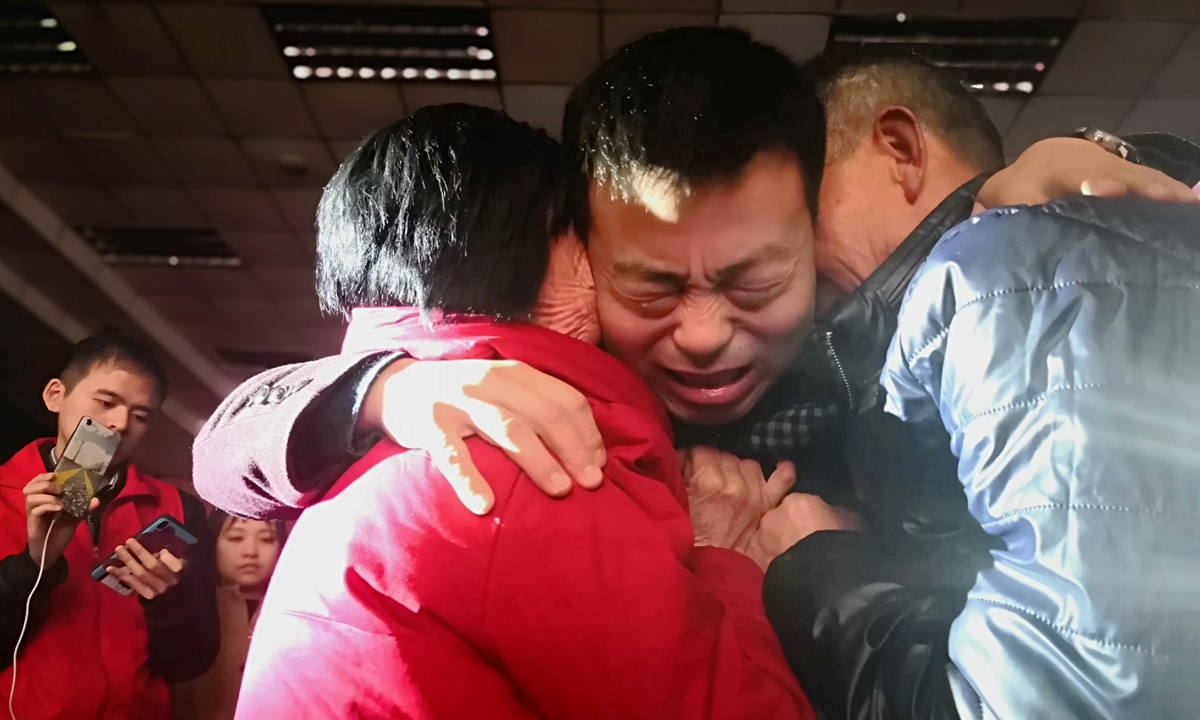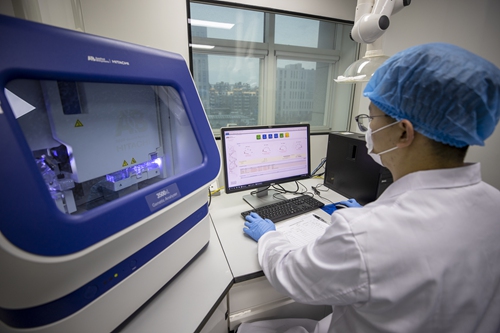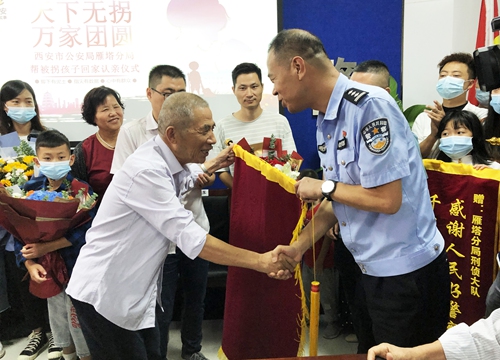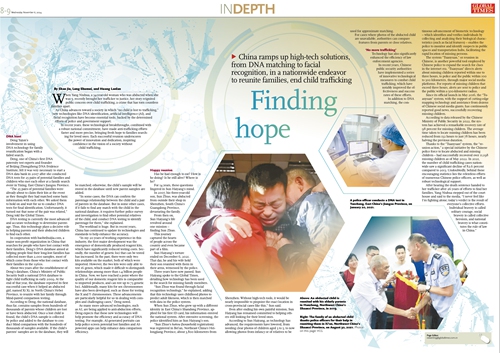
An abducted child is reunited with his elderly parents in Hanzhong, Northwest China's Shaanxi Province, in 2019. Photo: VCG
When Yang Niuhua, a 34-year-old woman who was abducted when she was 5, recently brought her trafficker to justice, her story reignited public concern over child trafficking, a crime that has torn countless families apart.
As China advances toward a society in which "no child is lost to trafficking," new technologies like DNA identification, artificial intelligence (AI), and facial recognition have become essential tools, backed by the determined efforts of police and government support.
In recent years, these technological breakthroughs, combined with a robust national commitment, have made anti-trafficking efforts faster and more precise, bringing fresh hope to families searching for loved ones. Each successful reunion underscores the power of innovation and dedication, inspiring confidence in the vision of a society without child trafficking.

A police officer conducts a DNA test in Yancheng, East China's Jiangsu Province, on January 20, 2021. Photo: VCG
DNA hunt Deng Yajun's involvement in using DNA technology for family reunification began with a failed search.
Deng, one of China's first DNA paternity test experts and founder of Beijing Zhongzheng DNA Evidence Institute, felt it was very necessary to start a DNA data bank in 2007 after she conducted DNA tests for 25 pairs of potential families and children who met each other at a family search event in Yixing, East China's Jiangsu Province.
"The 25 pairs of potential families were already about to claim their kin at the event as they thought they had matched some basic information with each other. We asked them to hold on and wait for us to conduct DNA tests for final identification. Unfortunately, it turned out that none of the pair was related," Deng told the Global Times.
DNA testing is currently the most advanced and accurate technology to determine parentage. Thus, this technology plays a decisive role in helping parents and their abducted children to find each other.
In cooperation with baobeihuijia.com, a major non-profit organization in China that searches for people who have lost contact with their families, Deng's DNA database aimed at helping people find their long-lost families has collected more than 2,000 samples, most of which come from those who lost contact with their families in the 1960s.
About two years after the establishment of Deng's database, China's Ministry of Public Security built a national DNA database to fight child trafficking in early 2009. At the end of that year, the database reported its first successful case when it helped an abducted girl, named Xi Xi, in North China's Hebei Province, to reunite with her family through blind-paired comparison testing.
According to Deng, the national database, thus far, contains samples from hundreds of thousands of parents whose children are lost or have been abducted. Once a lost child is found, the child's DNA sample is collected by police and added to the database to conduct blind comparison with the hundreds of thousands of samples available. If the child's parents' samples are in the database, they will be matched; otherwise, the child's sample will be stored in the database until new parent samples are added.
"In some cases, the DNA can confirm the parentage relationship between the child and a pair of parents in the database. But in some other cases, if it fails to find any match with the child in the national database, it requires further police survey and investigation to find other potential relatives of the child, and conduct DNA testing to identify parentage for them," she explained.
The workload is huge. But in recent years, China has continued to update its technologies and standards to help enhance the accuracy.
"In my 20 years of working experience in this industry, the first major development was the emergence of domestically produced reagent kits, which have significantly reduced testing costs. Secondly, the number of genetic loci that can be tested has increased. In the past, there were only two kits available on the market, both of which were imported. However, the two kits were only able to test 16 genes, which made it difficult to distinguish relationships among more than 1.4 billion people in China. Now, we have reached a point where the quality of our domestic reagent kits is comparable to imported products, and can test up to 73 genetic loci. Additionally, many kits for sex chromosomes have also been developed, such as those for testing the X and Y chromosomes. These advancements are particularly helpful for us in dealing with complex and challenging cases," Deng noted.
As many more advanced technologies, such as AI, are being applied to anti-abduction efforts, Deng expects that these new technologies will help promote the efficiency and accuracy of DNA testing. For example, AI-generated portraits can help police screen potential lost families and AI-powered apps can help enhance data comparison efficiency.

The family of an abducted child thanks police officers for their help in reuniting them in Xi'an, Northwest China's Shaanxi Province, on August 30, 2021. Photo: VCG
Happy reunionHas he had enough to eat? How is he doing? Is he still alive? Where is he?
For 14 years, these questions lingered in Sun Haiyang's mind.
In 2007, his three-year-old son, Sun Zhuo, was abducted from outside their shop in Shenzhen, South China's Guangdong Province, devastating the family.
From then on, Sun Haiyang's life revolved around one mission - finding Sun Zhuo.
This journey captured the hearts of people across the country and even became part of a film.
Sun Haiyang's torture ended on December 6, 2021. That day, he and his wife held their son reunited with them in their arms, witnessed by the police.
Three years have now passed. Sun Haiyang spoke to the Global Times, detailing how technology has been used in the search for missing family members.
"Sun Zhuo was found through facial recognition technology," he explained, adding that this technology uses childhood photos to predict adult likeness, which is then matched with data in the police system.
When Sun Zhuo, who grew up with a different identity in East China's Shandong Province, applied for his first ID card, his information entered the national system. After extensive screening, the police identified him as Sun Haiyang's son.
"Sun Zhuo's
hukou (household registration) was registered in Bei'an, Northeast China's Heilongjiang Province, about 3,800 kilometers from Shenzhen. Without high-tech tools, it would be nearly impossible to pinpoint the exact location in cross-provincial cases like this," Sun said.
Even after ending his own painful mission, Sun Haiyang has remained committed to helping others still looking for their loved ones.
According to Sun Haiyang, as technology has advanced, the requirements have lowered, from needing clear photos of children aged 3 to 5, to now allowing photos from infancy or of relatives to be used for approximate matching.
For cases where photos of the abducted child are unavailable, authorities can compare features from parents or close relatives.
'No more trafficking'Technology has also significantly enhanced the efficiency of law enforcement agencies.
In recent years, Chinese public security authorities have implemented a series of innovative technological measures to combat child trafficking, which have notably improved the effectiveness and success rates of these efforts.
In addition to DNA matching, the continuous advancement of biometric technology - which identifies and verifies individuals by collecting and analyzing their biological characteristics (such as facial features) - enables the police to monitor and identify suspects in public spaces and transportation hubs, facilitating the rapid location of missing persons.
The system "Tuanyuan," or reunion in Chinese, is another powerful tool employed by Chinese police to expand the search for clues in the internet era. "Tuanyuan" directs alerts about missing children reported within one to three hours, to police and the public within 100 to 300 kilometers, through major social media platforms. For reports of missing children that exceed three hours, alerts are sent to police and the public within a 500-kilometer radius.
Since its official launch in May 2016, the "Tuanyuan" system, with the support of cutting-edge mapping technology and assistance from dozens of Chinese social media giants, has continuously reported good news, successfully recovering missing children.
According to data released by the Chinese Ministry of Public Security in 2022, the system has achieved a remarkable recovery rate of 98 percent for missing children. The average time taken to locate missing children has been reduced from 132 hours to just 78 hours, nearly halving the previous duration.
Thanks to the "Tuanyuan" system, the "reunion action," a special initiative by the Chinese police force to locate abducted and missing children - had successfully recovered over 11,198 missing children as of May 2022. In 2021, the number of child trafficking cases nationwide saw a significant decline of 82.6 percent compared to 2013. Undoubtedly, behind these encouraging statistics lies the relentless efforts of numerous Chinese police officers, as well as robust technological support.
After hearing the death sentence handed to her trafficker after 26 years of efforts to find her families, Yang Niuhua stepped out of the court house and said to the media, "I never feel like I'm fighting alone; today's verdict is the result of everyone's collective efforts. Individual bravery is called solitary courage, social bravery is called collective heroism, and national bravery is what constitutes the rule of law in China."

Global Times







